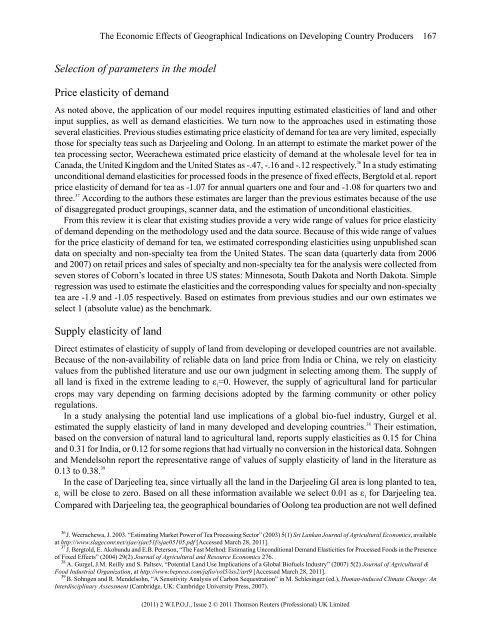WIPO Journal - World Intellectual Property Organization
WIPO Journal - World Intellectual Property Organization
WIPO Journal - World Intellectual Property Organization
Create successful ePaper yourself
Turn your PDF publications into a flip-book with our unique Google optimized e-Paper software.
The Economic Effects of Geographical Indications on Developing Country Producers 167<br />
Selection of parameters in the model<br />
Price elasticity of demand<br />
As noted above, the application of our model requires inputting estimated elasticities of land and other<br />
input supplies, as well as demand elasticities. We turn now to the approaches used in estimating those<br />
several elasticities. Previous studies estimating price elasticity of demand for tea are very limited, especially<br />
those for specialty teas such as Darjeeling and Oolong. In an attempt to estimate the market power of the<br />
tea processing sector, Weerachewa estimated price elasticity of demand at the wholesale level for tea in<br />
Canada, the United Kingdom and the United States as -.47, -.16 and -.12 respectively. 36 In a study estimating<br />
unconditional demand elasticities for processed foods in the presence of fixed effects, Bergtold et al. report<br />
price elasticity of demand for tea as -1.07 for annual quarters one and four and -1.08 for quarters two and<br />
three. 37 According to the authors these estimates are larger than the previous estimates because of the use<br />
of disaggregated product groupings, scanner data, and the estimation of unconditional elasticities.<br />
From this review it is clear that existing studies provide a very wide range of values for price elasticity<br />
of demand depending on the methodology used and the data source. Because of this wide range of values<br />
for the price elasticity of demand for tea, we estimated corresponding elasticities using unpublished scan<br />
data on specialty and non-specialty tea from the United States. The scan data (quarterly data from 2006<br />
and 2007) on retail prices and sales of specialty and non-specialty tea for the analysis were collected from<br />
seven stores of Coborn’s located in three US states: Minnesota, South Dakota and North Dakota. Simple<br />
regression was used to estimate the elasticities and the corresponding values for specialty and non-specialty<br />
tea are -1.9 and -1.05 respectively. Based on estimates from previous studies and our own estimates we<br />
select 1 (absolute value) as the benchmark.<br />
Supply elasticity of land<br />
Direct estimates of elasticity of supply of land from developing or developed countries are not available.<br />
Because of the non-availability of reliable data on land price from India or China, we rely on elasticity<br />
values from the published literature and use our own judgment in selecting among them. The supply of<br />
all land is fixed in the extreme leading to ε 1=0. However, the supply of agricultural land for particular<br />
crops may vary depending on farming decisions adopted by the farming community or other policy<br />
regulations.<br />
In a study analysing the potential land use implications of a global bio-fuel industry, Gurgel et al.<br />
estimated the supply elasticity of land in many developed and developing countries. 38 Their estimation,<br />
based on the conversion of natural land to agricultural land, reports supply elasticities as 0.15 for China<br />
and 0.31 for India, or 0.12 for some regions that had virtually no conversion in the historical data. Sohngen<br />
and Mendelsohn report the representative range of values of supply elasticity of land in the literature as<br />
0.13 to 0.38. 39<br />
In the case of Darjeeling tea, since virtually all the land in the Darjeeling GI area is long planted to tea,<br />
ε 1 will be close to zero. Based on all these information available we select 0.01 as ε 1 for Darjeeling tea.<br />
Compared with Darjeeling tea, the geographical boundaries of Oolong tea production are not well defined<br />
36 J. Weerachewa, J. 2003. “Estimating Market Power of Tea Processing Sector” (2003) 5(1) Sri Lankan <strong>Journal</strong> of Agricultural Economics, available<br />
at http://www.slageconr.net/sjae/sjae51f/sjae05105.pdf [Accessed March 28, 2011].<br />
37 J. Bergtold, E. Akobundu and E.B. Peterson, “The Fast Method: Estimating Unconditional Demand Elasticities for Processed Foods in the Presence<br />
of Fixed Effects” (2004) 29(2) <strong>Journal</strong> of Agricultural and Resource Economics 276.<br />
38 A. Gurgel, J.M. Reilly and S. Paltsev, “Potential Land Use Implications of a Global Biofuels Industry” (2007) 5(2) <strong>Journal</strong> of Agricultural &<br />
Food Industrial <strong>Organization</strong>, at http://www.bepress.com/jafio/vol5/iss2/art9 [Accessed March 28, 2011].<br />
39 B. Sohngen and R. Mendelsohn, “A Sensitivity Analysis of Carbon Sequestration” in M. Schlesinger (ed.), Human-induced Climate Change: An<br />
Interdisciplinary Assessment (Cambridge, UK: Cambridge University Press, 2007).<br />
(2011) 2 W.I.P.O.J., Issue 2 © 2011 Thomson Reuters (Professional) UK Limited

















